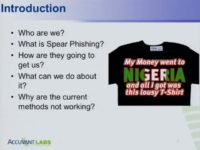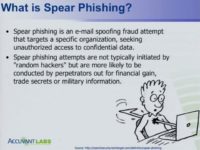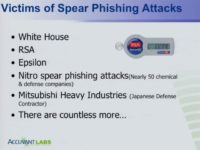Advanced Phishing Tactics Beyond User Awareness
Posted by david b. on February 11, 2013
Accuvant LABS’ Senior Security Consultant Martin Bos and the
Company’s Principal Security Assessor Eric Milam spotlight the issues
related to spear phishing from the pentester’s perspective during their
session at Hack3rCon event.Martin Bos: Hi everybody! We’re here from Accuvant LABS; we’re talking about some advanced phishing tactics. The main basis of our talk is, basically, why user awareness is not working.
So, this is the obligatory table of contents (see left-hand image). Basically, we’re talking about what spear phishing is. Just a disclaimer: we actually wrote this talk for some more corporate type conferences, and we’re just recycling it. We like it, we hope you all do, too; but some of the stuff is a little bit elementary in the beginning, because there were some more corporate type people we were talking to, so bear that in mind. We’re going to talk about how people are spear phishing us, what we can do about it, and why the current methods are not working. Who here has been phished? Who here is related to the Prince of Nigeria? Awesome, so we all know what a phishing email is.
So, my name is Martin, I’m Senior Security Consultant, also work on the Backtrack Linux project, and I’m a co-founder of a little conference like this one called Derbycon in Louisville, Kentucky. Eric Milam: And I’m Eric Milam, I’m Principal Security Assessor at Accuvant, also participate in the Ettercap project as well as a number of other initiatives.
Martin Bos: Alright, just in case anybody doesn’t know – what is spear phishing? What’s the difference between phishing and spear phishing? Phishing is when you get an email like, you know, that you’re related to the Prince of Nigeria; everybody’s got one of those. Spear phishing is, basically, when we as attackers – and when I say “We as attackers,” I mean pentesters, not attackers for real – are trying to target a specific organization, group of people, business unit, and sometimes an individual, although I’ve got really big qualms about how good spear phishing one person works. However, it’s happened. So, when we’re talking about spear phishing, we’re talking about targeting an organization.
Spear phishing is one of the most popular externally facing attacks on the Internet today.
Alright, this is basically my validation for why we pentest (see left-hand image). I actually got into several arguments at the last conference that we were at about people that said that pentesting was pointless and that there was no reason to do it. If anybody knows me, I like to argue, but if I get up and leave, I’m really mad. Well, I got up and left this dude’s conversation. We do these spear phishing attacks against ourselves so that we can test our clients’ security systems. We’re not just testing their users, we don’t just want to make the users look stupid. What we’re doing is we’re testing all of their controls that are in place to prevent this type of thing: you know, egress filtering, network segmentation, incident response – I mean, there’s a whole chain of things that need to be tested by a successful spear phishing attack.
Embarrassing users is not the goal, and showing users that they’ll click on anything is not the goal. Obviously, there is a little subsection for user awareness, I’m not against it, but I’m just saying that I don’t think we need to put all our eggs in the user awareness basket.
Eric Milam: And if you guys think about someone clicking a link – until the shell gets out there’re several layers of defense, and that’s what we’ll talk about as well.
Read next: Advanced Phishing Tactics Beyond User Awareness 2: Anatomy of a Spear Phishing Attack





No comments:
Post a Comment